The 914 Is No Longer Porsche’s Ugly Duckling
Purists used to scoff at the 914. Part Porsche and part VW, it didn’t really fit in either camp. It used to be cheap, too. A bargain, even, especially considering the exotic layout and premium badge. And you could learn to love (or at least like) the looks.
Purists don’t scoff anymore, though—they haven’t for a while. 914s are no longer cheap, either.
Porsche has put out some ugly ducklings in more recent memory (looking at you, 996 and Panamera), but the 914 is arguably their original ugly duckling. Some versions are still attainable, still among the cheaper ways to slide into P-car ownership despite prices doubling in the last decade. Others are downright expensive more than tripling in price over the last decade. But they’re all fun, reasonably practical classics, now recognized as an important piece in the history of the company (well, companies) that built them.
Background
The second half of the 1960s was not the best of times for Volkswagen, at least not at home. Germany had its first postwar recession in 1966, while VW faced more and increasingly sporty domestic competition from Opel, Ford, and BMW. Wolfsburg needed an image boost, and its then current range-topper—the Type 34 Karmann Ghia—was on its way out. Porsche, meanwhile, looked to replace its entry-level 912 model that was also headed for retirement. As part of a development agreement between the two companies, which already shared history going back to the ’40s, VW asked Porsche to develop a model that would kill two birds with one stone. The 914 was that stone, planned around many of the components of Volkswagen’s upcoming 411 sedan but utilizing some Porsche parts and plenty of all-new pieces.
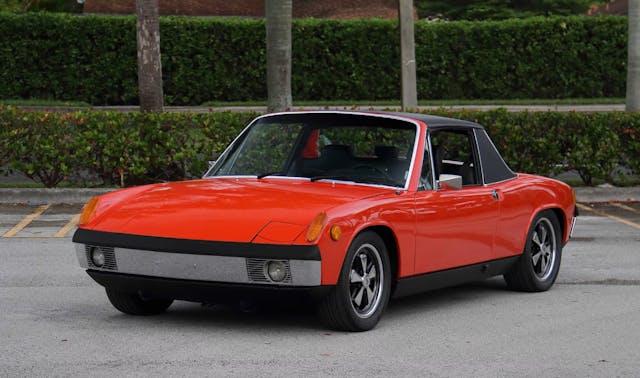
Mid-engine marvel with two personalities
By the late 1960s, mid-engine designs had conquered Formula One, Indianapolis and endurance sports car racing, while road-going sports cars like the Lotus Europa and Matra Djet brought mid-engine mania to the streets. Porsche wasn’t far behind with the 914. Although this was only the third street car ever introduced by Porsche, the 20-year-old company’s sports cars already had a distinctive look. This one didn’t have it. It didn’t look like any VW on the road, either. German mag auto motor und sport put it this way: “the 914 is not exceedingly pretty, but it is functional, low and sporty.” Sports Car Graphic, meanwhile, called it “a pleasant eyesore.” Wearing integrated bumpers and Porsche’s first ever pop-up headlights, the 914 was lower, wider, longer in wheelbase and more aerodynamic than the contemporary 911. It also boasted a lower center of gravity than Porsche’s signature sports car.
The long doors, the rear wheel tucking under the bodywork slightly, and the black lower side panels make it appear even lower. A trunk at each end also makes the 914 more practical than it looks. The removable targa roof panel fits in the rear trunk, while also giving the joy of open-air motoring but also the safety, noise reduction, and at least some of the rigidity of a coupe. The 914 boasted torsional stiffness equal to the contemporary 911 coupe and higher than that of the equivalent 911 Targa.

The 914 made its public debut at the 1969 Frankfurt Motor Show and went on sale for 1970. Nestled behind the driver and between the axles was one of two engines, and with them came two very different personalities.
The lower, mass-market model had a 1679-cc fuel-injected Volkswagen flat-four with 85 horsepower, shifting through a 5-speed manual. Underneath were suspension and steering similar to the setup in the 911, although there were now coil springs in the rear, and disc brakes front and rear. The whole package weighed in at just under a ton. This four-cylinder model, aka the 914/4, was built in full by Karmann, the Osnabrück-based contract manufacturer that had built the Karmann-Ghia and Beetle Cabriolet for Volkswagen as well as various coupe bodies for Porsche. To keep VW happy, these were badged and sold as “Volkswagen-Porsche” at Volkswagen dealerships in Europe. In the United States, which wound up buying most 914s, the 914 sold exclusively as a Porsche through the “Porsche+Audi” distributorship.
There was also a six-cylinder 914—the 914/6—which boasted 125 horsepower despite tipping the scales at only about 100 lbs more than the 914/4. The 914/6 got the Weber-carbureted 2.0-liter engine from the contemporary 911T (then the entry-level 911), different gearing, ventilated front disc brakes, and other upgrades like chromed bumpers and special wheels. The proper Porsche exhaust note with the extra two cylinders is distinctive, but visually there isn’t much to distinguish a 914/4 from a 914/6. One quick thing to look out for, though, is the wheels: a 914/6 has five wheel studs while the 914/4 has four. The 914/6 was also screwed together differently. Karmann built, painted, and trimmed the bodies, but for final assembly the cars went through the same line as the 911s at Porsche in Zuffenhausen. Even in Europe, this version was sold exclusively as a Porsche with no VW badges to be seen.

Reception and changes
With its confusing mixed heritage and high price, the 914 raised some eyebrows when it arrived in the States. It got mixed reviews in the press, too. The main criticisms of the four-cylinder model came down to simple performance per dollar. Most magazine tests found that on acceleration the 1.7-liter 914 was no faster than the old 912, and was more on par with the old 356 from the early ’60s. This was 1970, remember. American drivers were living at the peak of American muscle and were waist-deep in sports cars, too. The game-changing Datsun 240Z was already on the scene. Car and Driver was blunt, calling it “the slowest over $2,500 sports car we’ve tested in several years,” and bemoaning “at low speeds the engine is distressingly weak…and there are never any bright spots in the performance to offset the annoyance.” C/D also took a dig at the interior—”[n]o one else in this price class would dare offer such meager instrumentation,” and another one at the styling—”the fluidity of line of an Erector set project.”
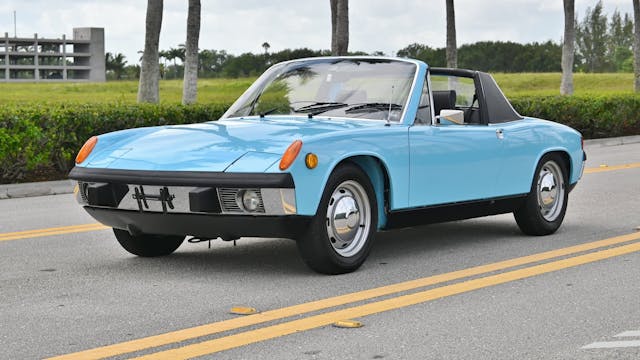
Road & Track felt similarly, concluding that “around town and on winding roads, the 914’s performance can be characterized as rather busy, noisy and torqueless,” but “on the highway, quiet and relaxed.” Sports Car Graphic gave genuine compliments to the impressive outward visibility, and a backhanded one to the acceleration, which “is tolerable for a Porsche, but outstanding for a Volks.” Other critiques took aim at the 914’s vague shift linkage and the non-adjustable passenger’s seat, but there was plenty of praise for the sharp cornering of this low, wide, mid-engine car.
Motor Trend was generally more forgiving, noting that “[h]igh speed cornering in the 914 is an enjoyable experience with mild doses of over- and understeer…although the basic cornering characteristics are neutral…it is a most forgiving car.” Motor Trend also gave 914 its Import Car of the Year award in 1970.
Predictably, the 914/6 got more love. Due to the complexities of Porsche’s relationship with VW and Karmann, however, Porsche was unable to price the 914/6 competitively. Its price was nipping at the heels of entry-level 911s, so comparisons were inevitable. “The main questions,” mused Road & Track, are “How much faster than the four is it? Is it as fast as the current 911T? Is it worth $2,500 more than the four? Is it worth within $500 of the 911T? The answers, respectively, are: Much. Not quite. Yes. No.” Car and Driver concluded “[i]t’s about half the cost of a 911S – and about half as good as a 911S.”
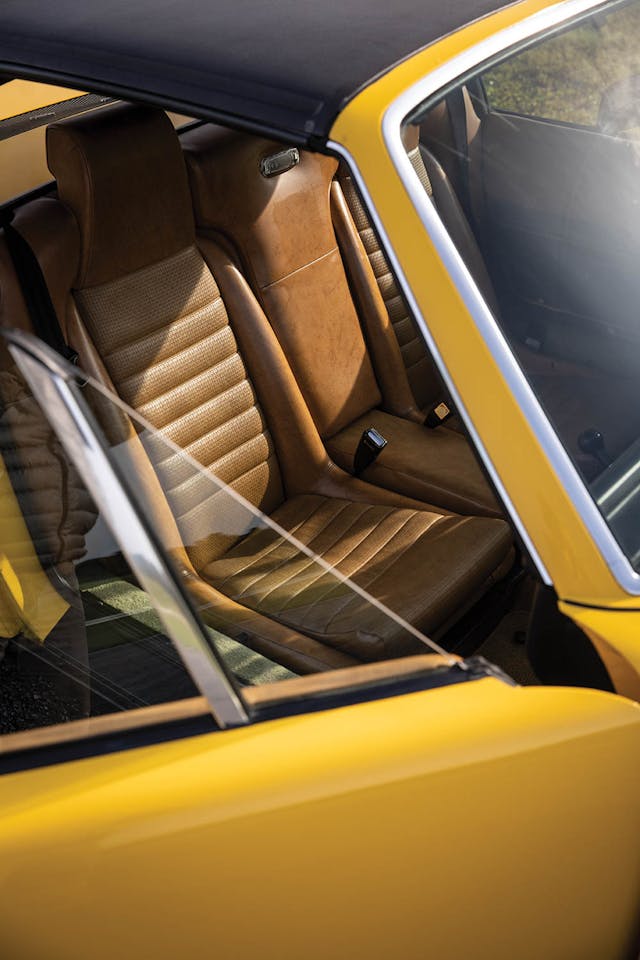
It didn’t help either 914 that in the early ’70s the value of the Deutschmark was increasing against the dollar, so Porsche regularly increased the price to keep up with the changing exchange rates. For the 914/6, that was untenable. Despite promise on the race track, including class wins at Le Mans and Daytona, victory at the Nürburgring’s Marathon de la Route and regular success in SCCA competition, the six-cylinder 914 was dead weight in the showroom. After 1972, Porsche discontinued the 914/6 after selling just 3351 units.
The four-cylinder car, meanwhile, did well. In America, Porsche was selling three times as many 914s as they had 912s. By 1971 it had dethroned the Opel GT as Germany’s most prolific sports car.
Updates to the 914 were regular but minor. For 1972, the passenger’s seat changed from a fixed chair with movable footrest to an adjustable one with no old-fashioned footrest. Porsche also added better soundproofing, and improvements to the 1.7-liter VW that led to better fuel economy. With the 1973 model year the 914/6 was gone with no direct replacement, but the 914 range did add a 2.0-liter model powered by a bored and stroked version of the 1.7. Fuchs alloy wheels came standard on this 2.0 model and were optional in the rest of the range. There were more soundproofing improvements for 1973 as well as a much improved shift linkage, and US cars got two rubber bumper guards to meet new crash rules. Car and Driver liked the 2.0-liter model, calling it “a whole lot better…now up to the level the 914 should have been when it was first introduced,” while Road & Track said, “The 2.0-liter engine is better than the figures show.”
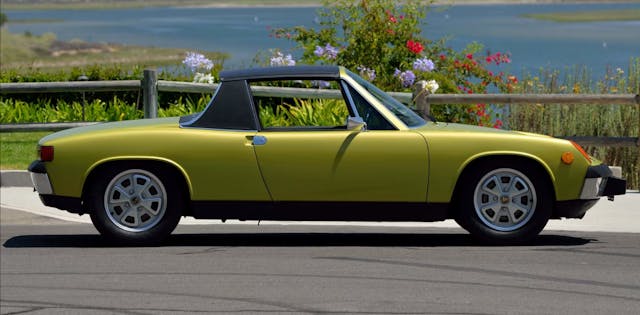
For 1974, Porsche raised the price of the 914 but the 1.7-liter base car had been bored out to 1.8. US cars got rear rubber bumper guards to match the front, and all 914s got new steel sports wheels similar to the ones found on the contemporary Super Beetle. There were also Limited Edition 914s in North America. Marketed to capitalize on Porsche’s domination in Can-Am racing, the special 914s sported either “Bumblebee” (black with yellow) or “Creamsicle” (white with red) paint schemes with a front spoiler, anti-roll bars, driving lights, aluminum wheels, extra gauges, and painted roll bar trim. About 1000 were built.
The 914 sprouted new bumpers in 1975, and US dealers offered a Performance Group option with anti-roll bars, eight-spoke cast aluminum wheels, and a front spoiler. Emissions changes in the US also led to a new exhaust, with California cars gaining a catalytic converter. Tartan cloth seat inserts also became an option, and there was a new range of colors to choose from.
Despite a mixed reception and unfavorable pricing, the four-cylinder 914 was a sales success, with 115,596 built from 1970-76. After the close of 914 production, the 2.0-liter model’s engine lived on in the one-year-only 912E, an interim model that bridged the gap between the 914 and the upcoming water-cooled, front-engined 924.
As 914s aged, they quickly turned into affordable used sports cars. As an entry-level developmental dead end for Porsche, which went in a very different direction with its 924 and 944, the 914 became the de facto (and original) “cheap Porsche.” When we created the Hagerty Price Guide Indexes back in 2009, we naturally included the four-cylinder 914 in the “Affordable Classics” index. After all, really good 914s were worth well under 20 grand then, and driver-quality cars could be had for barely 10. Today, though, it’s a stretch to call any 914 truly “affordable.”
Following the explosion in values for air-cooled 911s that started in the mid-2010s, attention turned to 914s starting in mid-2018 and prices for them surged until late 2021. The much rarer six-cylinder cars, meanwhile, have long had a more dedicated following and more lasting respect in the Porsche community, and their values have been gaining fairly consistently since the early 2010s. The tables have also turned vis-à-vis the 911 that gave the 914/6 its engine. The 914/6’s condition #2 (“excellent”) value of $120K is now higher than that of the 911T coupe ($93,000) and Targa ($86,000).
In general, Porsches and Volkswagens have a broad appeal that skews younger than many 50-year-old automobiles. Not so with the 914, with Baby Boomers making up nearly half of all insurance quotes for 914s, even though Boomers make up less than a third of the market as a whole. This is a bit surprising given that the 914 is a comparatively less pricey ticket into the classic P-car club. Then again, there are also newer, more practical and usable Porsches out there. Boxsters, Caymans, 944s, 968s, and even 996-generation 911s are all out there for similar or less money than what a clean four-cylinder 914 goes for these days.
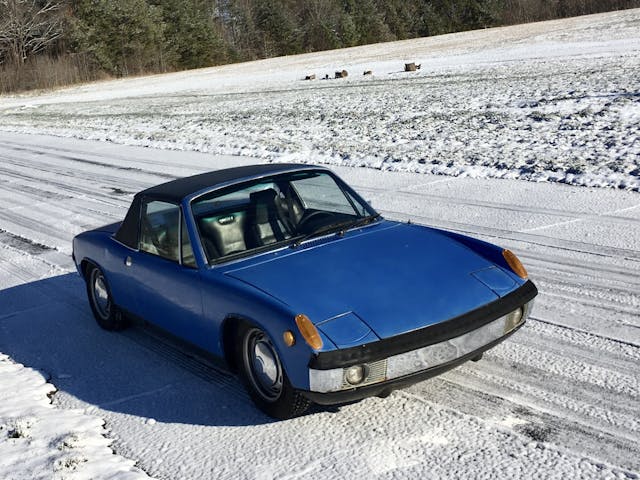
Looking outside the Porsche camp, there are also lots of classic British and Italian sports cars that have better looks, more personality, and similar performance that come much cheaper than a 914. Is a 914/4 a better car than an MGB? Probably. Is it twice as good, as prices suggest? That's a much harder argument to make.
With time, Porsche's ugly duckling has grown up, even if it never became a swan. The VW stigma has worn off after 50 years and, just as the Dino was eventually embraced by the Ferrari faithful, Porsche people now embrace the 914 as a proper P-car and they pay proper P-car prices for it. After peaking a couple of years ago, though, prices have mostly stayed flat even through the pandemic boom, so they appear to be fully priced for now.

***
Check out the Hagerty Media homepage so you don’t miss a single story, or better yet, bookmark it. To get our best stories delivered right to your inbox, subscribe to our newsletters.



One thing that has haunted Porsche is in the need for volume the affordable Porsche was counter to their image.
The 924 suffered this as well the 944 to some extent.
Today they can gain volume with the VW based SUV models and let the car prices get higher to still hold sone exclusivity.
The one issue on today’s 914 is rust. They break in half here so buying is key to look it over carefully.
I feel if Porsche had raced these in the SCCA in a class like the Miata series runs it could have really done the cars image a lot of good. . Even at a low cost the image building of the one car series and Alsonthe offer of an affordable race car out weighs the affordable Porsche.
These are fun cars and I’ve always liked them, but they have gotten overpriced IMO. I owned a ’74 LE “Bumblebee” in the mid ’80s, it was pristine and I had a lot of fun autocrossing it and just using it as my daily driver. But, even with the 2.0L engine it lacked power, and a few years after I bought it I had the chance to purchase an early “two-digit” ’65 Shelby GT350, which was more my style, so I sold the 914. Today I’d much rather have a modern P-car, like a 987 Boxster or Boxster S, for a lot less money than nice 914s go for, but is more entertaining, yet with all the reliability, amenities, and daily drivability that only a modern car can provide.
I bought a “time warp” 1976 914 2.0 with sway bars and gauge cluster from a car donation company. It had floor mounted 8 track player and CB radio along with original cocoa mats. I paid $650 for it and was able to drive it home. After a few tanks of fresh gas had run through it and an oil change, that car was actually very dependable. Bone stock. I auto crossed it with the Porsche club and did really well. I never modified it and it was a great driving car. My wife never liked being a passenger though. But driving to Monterey on an early morning on my way to a club autocross from SF bay area with the top off and the heater cranked up it would go 70 to 80 mph the whole trip. I had to sell it to someone out of state because of the Smog laws in California on cars after 1975 and cost of parts needed to pass smog. I later bought and still own a Renegade converted 914 with a 327. Really fun but for various reasons, not all the cars fault, I have not enjoyed it as much as my 76 with the 2.0. Regarding pricing they have followed a similar path as the BMW 2002. Both great cars but I bought a M Coupe for less than a nice 2002 costs these days. Same applies to the 914 vs the Boxster. By the way before my 914 I was all BMW 2002. Porsche is a much better handling car than the 2002, especially at the limits, but it is harder to live with as a daily.
Coincidentally, or perhaps not Andrew, Sam Poseys feature before the 24 showed a 914 ( 14/6 GT ? ) spinning out when being raced at Daytona. I’ve always thought these were cool looking cars. They, like the Europa, appear somewhat differently in real scale. While the X1/9 would probably be it’s closest competitor for the time, even with its styled by Bertone body I prefer this little VW /Porsche . It’s also is a car that I can imagine doing a niche market modern comeback. Along with the Macan why not a new 914 like EV ? Smaller so more affordable yet still a Porsche. Kind of an open air commuter for the professional who needs to go into the office 2 or 3 times a week and the like if you get my drift.
As a 356 owner at the time, I was confused when the 914 came out. Didn’t really know what to think. My 356 had the same performance and was much better to look at. I sort of half accepted them and never had any desire to have one. The only thing that impressed me was the mid-engine. They have always remained in the background of my mind. I think cars, in general, during the last decade have been beaten with the ugly stick so I can see why this little bastard child is now accepted as cute.
As a former 914 owner, I think the car is still an ugly duckling, it’s just that prices have come up on just about every classic car worth owning. I had an X1/9 as well and greatly preferred it to the 914 — it had superior styling, handling and exhaust note. Maybe the 914 was slightly quicker, but not significantly so — especially all these years later when both are considered incredibly slow cars. Most period 914 reviews by automotive journalists panned the car as too expensive and half-baked. Reviews were actually much better for it’s replacement: the 924.
GREAT synopsis ! Very accurate on all accounts, so Thank YOU Hagerty for a great article. Shortly after I entered the Porsche world of exciting cars, with rides in 911s, 928s, a 924, I had to have one. Road & Track, AutoWeek, C&D, Motor Trend, all convinced me of the perfect handling and braking qualities of a new Porsche were found in the 944 (so, 1983 purchase of a 944 delivered as a 1984 after long wait on the list). I began to look for as clean and perfect 914 to add to my small group of ‘collectibles’ and drivers. It was a tough search even then and many rusty, broken, and suspect cars were encountered. Even looked at a rust free 2.0 in Monterey that had been torn up badly on the underside after leaping a concrete parking berm….. discovered on the lift I required it be up on for inspection. Then came along a Sunflower early ’74 with a very low build date for that year: 00089 with all the idiosyncrasies of ’73 carryover pieces such as the silver button centers on dials, chrome windshield squirters, etc. Steelies on the car, a ‘PORSCHE stripe’ as seen in above photo, ZERO rust issues (even in the battery box and Hell Hole) but a car which also needed engine work. Bought for $750 in 1994 by me, this very 914 with 60,000 miles would be my car till the day I die. I had it repaired at the dealership I found it at, got clear title from the guy who had abandoned it due to mechanical costs, then he was killed a short while later on a head on collision on his cycle with a car. It all came down to timing and fate regarding all involved.
I still own it and it gets driven only on sunny, dry days. It is a car which is near perfection on drive-ability with a polar moment of inertia that defies explanation unless experienced. I encourage anyone looking for one of these to consider the element of rust as the pre-eminent deciding factor for one’s budget. A tipped out at bottom of the passenger side rear wheel means extreme and expensive repair and may be accompanied by a binding right door, a hole under the battery box, and accompanying holes in floor and behind seat back. Look for all of these as the costliest of extremes; all else can be worked with relatively easier and with less monetary outlay. What is left to find out there moderately priced is going to most likely have these issues, even dry southern/desert 914s. It is my belief they all need a shot at redemption because so very many have been lost….. and every Porsche deserves to have someone to love and respect it.
I never considered them as looking like Ugly Ducklings – they just didn’t look like a Porsche – or at least what most of us thought a Porsche SHOULD look like. After Speedsters, 911s, and the myriad of sleek racecars we’d seen, this just didn’t fit the mold. But if one viewed it through the lens of what the makers were trying to accomplish (well explained in the article) the 914 actually was a success. It took a few years to iron some things out, but they did get quite good, IMO (I had a ’74 1.8). Loved the darned thing!
They’ve always been my favorite, had no idea everyone didn’t love them!
…always wanted one but had to ‘settle’ with the 2.0litre, from a spectacular mountainside wreck, that I jammed into my 70 beetle… and no front discs lolol..and sketchy electrics.. oh the 80’s were a different time for sure… fifty dollar cars everywhere.. if only I had saved a few…..
I bought a brand new 1971 914 from Don Miller Porsche+Audi (long gone) in Dallas, TX for $3,595, which was the MSRP. It had no options. Not even a radio. No discounts. White with a tan vinyl interior. It was my first new car purchase. I considered a TR6 and a 240Z, similarly priced. Drove it for two years, and due to the rapid price increases as the result of the dollar/mark exchange rate, sold it for more than I paid for it. All in all, it was a very good and fun car to drive. Slow acceleration but excellent cornering, handling and braking. Gas mileage was +30, and with a 16 gallon tank, excellent range. Plenty of room with front and rear storage. Never had a problem. Top speed was about 110. I recall driving a 914-6 at the dealership but it was $4,995 and out of my price range.
Rust or frame stiffness test. Take off top, stand in passenger seat. See if door opens and closes smoothly.
Porsche has put out some ugly ducklings in more recent memory (looking at you, 996 and Panamera)
I’m sorry the 996’s were not ugly at all, I never understood the misplaced hate they got because of some headlights. Get over it! Some race cars like the Porsche 911 GT1 Evolution had similar headlight back than also and no one complains about them.
Loved this article. I have a 1974 914 2.0 L that I bought in 1975. It is sunflower yellow. It has over 300K miles, and the engine was rebuilt at about 275K, and the transmission at about 225K. I love this car and would never part with it. I only drive it on sunny days now, but it is in pristine condition, a joy to drive and just puts a big smile on your face whether you are the driver or observer.
Had a ’71 1.7L that I bought from a couple in NJ in 1977 after summer working as a CDF hand crew monkey. Adjusted the valves, changed the oil, new plugs and off I went for a three and a half day drive back to the Bay Area. I loved that car (and to me, a 22 year-old “kid”, it was a “real” Porsche, especially after my sweet but gnarly ’70 MGB) … and even though it was already showing its rust, I was smitten. Loved it, and so easy to work on. I have a 912E now. That’s pretty cool too, it’s esoteric and certainly another “real” Porsche…even after a not so easy to work on ’71 911T (with an E motor and Weber D’s)! Ha! All cheap cars but not anymore.